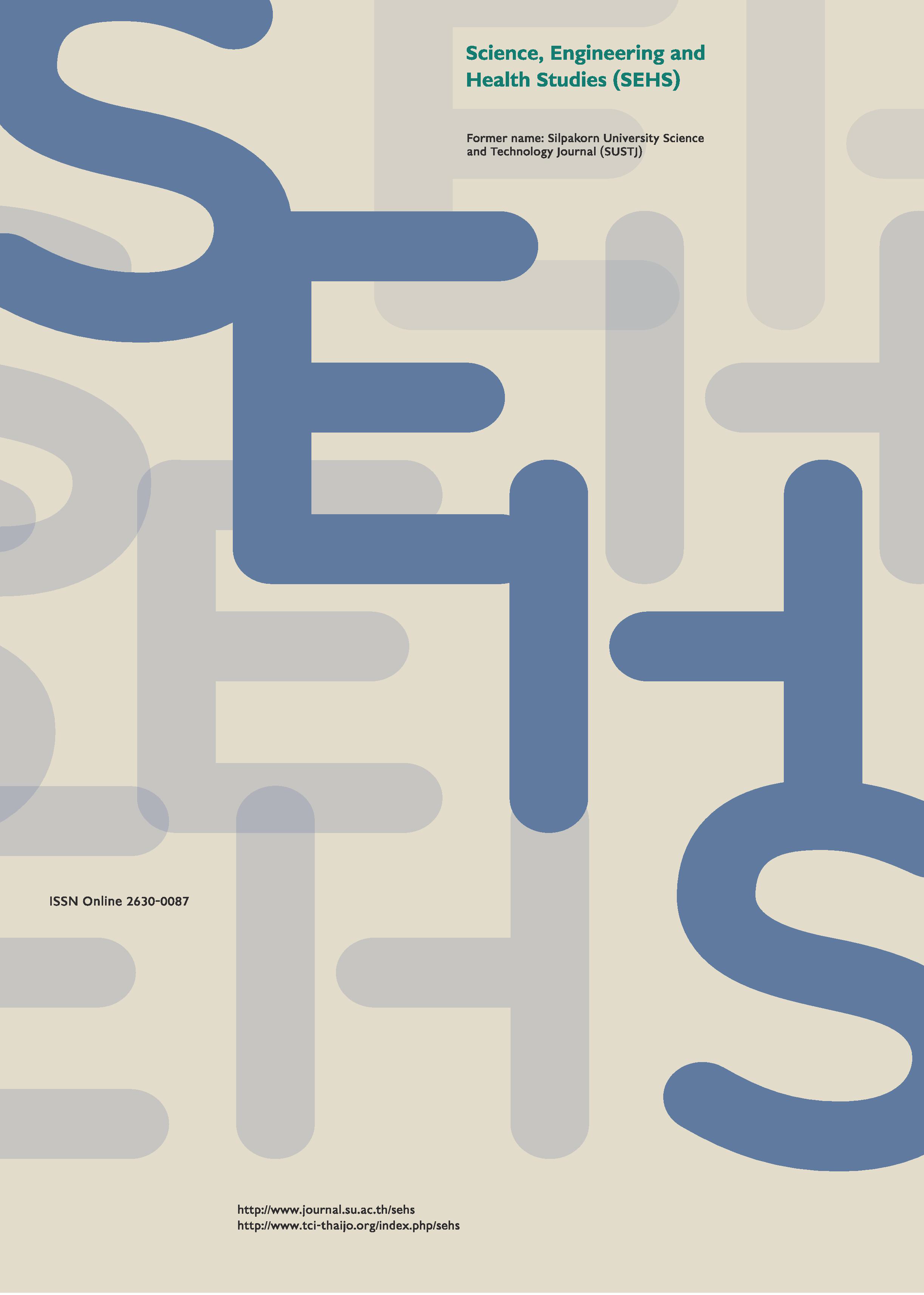Salt reduction in salted jellyfish (Lobonema smithii) using a mechanical washing machine
Main Article Content
Abstract
Edible salted jellyfish sold in local markets need proper rehydration before cooking. Multiple washing steps with water is a common practice but time consuming and labor-intensive. In the industrial, use of a washing machine for desalination is an alternative approach. This research aimed to determine the effect of water wash cycles in a jellyfish washing machine on salt reduction of rehydrated jellyfish. Salted jellyfish with an irregular sheet were mechanically washed for 1, 2, and 3 cycles, each for 15 min and with new wash water. Results showed that changes in the percentage of rehydrated jellyfish calculated as washing yield (%) and salt content determined by three analysis methods (titration, atomic absorption spectroscopy, and X-ray fluorescence spectrometry) significantly decreased with increasing numbers of wash cycles. The salt reduction may be due to the agitation and dilution effect during wash cycles. However, extended wash cycles caused soft texture and generated broken pieces, resulting in a higher loss of desalted product. Therefore, the selected wash cycle of 2 times yielded acceptable flesh quality and remaining salt content (1.02%). Using a mechanical washing machine could be an appropriate procedure for jellyfish rehydration, saving time, and increasing productivity.
Downloads
Article Details
References
AOAC. (2000). Official Methods of Analysis of AOAC International, 17th, Maryland, USA: AOAC International.
Amerine, M. A., Pangborn, R. M., and Roessler, E. B. (1965). Principles of Sensory Evaluation of Food. 1st, New York: Academic Press, pp. 82-86.
Belitz, H. D., Grosch, W., and Schieberle, P. (2009). Food Chemistry, 4th, Berlin: Springer-Verlag Berlin Heidelberg, pp. 1-89.
Brotz, L., Schiariti, A., López-Martínez, J., Álvarez-Tello, J., Hsieh, Y. H. P., Jones, R. P., Quiñones, J., Dong, Z., Morandini, A. C., Preciado, M., Laaz, E., and Mianzan, H. (2017). Jellyfish fisheries in the Americas: origin, state of the art, and perspectives on new fishing grounds. Reviews in Fish Biology and Fisheries, 27(1), 1-29.
Chancharen, P., Laohakunji, N., Kerdchoechuen, O., and Thumthanaruk, B. (2016). Extraction of type A and type B gelatin from jellyfish (Lobonema smithii). International Food Research Journal, 23(1), 419-424.
Damodaran, S., Parkin, K. L., and Fennema, O. R. (2008). Fennema’s Food Chemistry. 4th, London: CRC press, pp. 18-41.
Department of Fisheries. (2019). Fisheries Statistics of Thailand 2017. [Online URL: https://www4.fisheries.go.th/local/file_document/20200714161650_1_file.pdf] accessed on February 20, 2020.
Frankowski, K. M., Miracle, R. E., and Drake, M. A. (2014). The role of sodium in the salty taste of permeate. Journal of Dairy Science, 97(9), 5356-5370.
Hsieh, Y. H. P., and Rudloe, J. (1994). Potential of utilizing jellyfish as food in western countries. Trends in Food Science & Technology, 5(7), 225-229.
Hsieh, Y. H. P., Leong, F. M., and Rudloe, J. (2001). Jellyfish as food. Hydrobiologia, 451, 11-17.
Hu, J., Zhou, F., Ln, Y., Zhou, A., Tan, B. K., Zeng, S., Hamzah, S. S., and Lin, S. (2019). The effects of photodynamically activated curcumin on the preservation of low alum treated ready-to-eat jellyfish. LWT - Food Science and Technology, 115, 1-6.
Huang, Y. W. (1988). Cannonball jellyfish (Stomolophus meleagris) as a food resource. Journal of Food Science, 53(2), 341-343.
James, C. S. (1995). Analytical Chemistry of Foods, 1st, London: Springer, pp. 41.
Kromfang, I., Thumthanaruk, B., and Laohakunjit, N. (2009). Effect of acetic acid, citric acid and lime juice on constituents and properties of concentrated protein extracts from sand jellyfish (Rhopilema hispidum) and white jellyfish (Lobonema smithii). In Proceedings of 47th. Kasetsart University Annual Conference, pp. 751-759. Bangkok, Thailand. (in Thai)
Omori, M., and Nakano, E. (2001). Jellyfish fisheries in Southeast Asia. Hydrobiologia, 451(1-3), 19-26.
Pedersen, M. T., Brewer, J. R., Duelund, L., and Hansen, P. L. (2017). On the gastrophysics of jellyfish preparation. International Journal of Gastronomy and Food Science, 9, 34-38.
Pedersen, M. T., and Vilgis, T. A. (2019). Soft matter physics meets the culinary arts: From polymers to jellyfish. International Journal of Gastronomy and Food Science, 16, 1-9.
Presle, M., Trias, D., and Boileau, S. (2017). Methodology and physicochemical characterization techniques used for failure analysis in laboratories. In Reliability of High-Power Mechatronic Systems 2 (Hami, A. E., Delaux, D. and Grzeskowiak, H., eds.), 7th, pp. 211-240. London, UK: ISTE Press; Oxford: Elsevier.
Rodsuwan, U., Thumthanaruk, B., Kerdchoechuen, O., and Laohakunjit, N. (2016). Functional properties of type A gelatin from jellyfish (Lobonema smithii). International Food Research Journal, 23(2), 507-514.
Shahine, S., and El-medany, S. (1979). Selective microdetermination of phosphate based on Volhard’s titration. Microchemical Journal, 24(2), 212-216.
Silaprueng, S., Thumthanaruk, B., and Wongsa-ngasri, P. (2015). Comparative functional properties of jellyfish (Lobonema smithii) protein hydrolysate as influenced by bromelain and hydrochloric acid. Journal of Food Science and Agricultural Technology, 1, 171-176.
Skoog, D. A., Holler, F. J., and Crouch, S. R. (2017). Principles of Instrumental Analysis, 7th USA: Thomson Brooks Cole, pp. 230-250.
Thai Industrial Standard Institute. (2006). Drinking Water. In Thai industrial standard. [Online URL: www.fio.co.th/web/tisi_fio/fulltext/TIS257-2549.pdf] accessed on August 8, 2020.
Thumthanaruk, B., Suadach, J., and Benjapongwimol, D. (2011). Comparative study of the use of insee peel of Peltophorum dasyrachis and salt in the production of cured cup jellyfish (Acromitus flagellatus). Agricultural Science Journal. 42, 393-396. (in Thai)
Thumthanaruk, B., and Lueyot, A. (2014). Functional properties of jellyfish (Lobonema smithii) protein hydrolysate. The Journal of Applied Science, 13(2), 33-42. (in Thai)
Torri, L., Truccillo, F., Bonelli, S., and Leone A. (2020). The attitudes of Italian consumers towards jellyfish as novel food. Food Quality and Preference, 79, 1-10.
Wongsa-ngasri, P., Virulhakul, P., and Thumthanaruk, B. (2008). Study of salted jellyfish production in commercial. In Proceedings of The Annual Conference on Fisheries, pp. 284-297. Bangkok, Thailand. (in Thai)
World Health Organization (WHO). (2013). WHO issues new guidance on dietary salt and potassium. World Health Organization [Online URL: who.int/mediacentre/news/notes/2013/salt_potassium_20130131] accessed on February 9, 2020.


